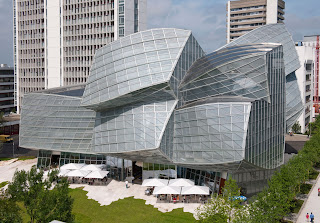Gehry's architectural journey began while in university at USC. During this time, he found himself spending more of his time around the art students as opposed to his fellow architectural classmates. Longtime friend of Gehry, Charles Arnoldi, spoke in reference to Gehry's commonality with artists, "we see infinite possibilities and Frank was hanging around people like us." He was inspired by this different language, and wasn't afraid to incorporate such inspiration into his work. Associates of his firm often say they're looking up painting he's referred to in design discussions. When director of the Los Angeles County Museum of Art would hear complaints that Gehry had taken an idea from them, "I would smile ans say that's part of his genius. He has the incredible ability to absorb all kinds of ideas." While attending the Harvard Graduate School of Design, Gehry had become infatuated with Le Corbusier's paintings, Gehry was impressed with how he developed his own language, his shapes were in his paintings and in his buildings, he was painting his ideas.
| Taureau III (Bull III) - Le Corbusier 1953 http://www.tate.org.uk/art/artworks/le-corbusier-bull-iii-n06224 |
While Gehry was still starting out in southern California, he became very familiar with Japanese Classicism, a look that was synonymous with southern California. It focused on features of wood and light, Gehry spoke to this preference, "it as the whole aesthetic that worked here and was accessible to a young architect because you could imagine doing it. That's the key, I think." In his youth, Gehry studied every aspect of Frank Lloyd Wright's work he could. Wright's approach was the Californian style that Gehry could access. This notion of wood and light can be seen in one of Gehry's first designs, Steeves house, is very similar to the aesthetic approach of Frank Lloyd Wright. And despite the fact that Gehry's design sense has evolved an immense amount over his life, he still incorporates his early philosophies into some of his more recent work. Shown below is an interior view of the Disney Concert Hall he designed in Los Angeles, which features the aspects of wood and light that he started out with.
 |
| Steeves House - Frank Gehry, Greg Walsh - 1960 http://anavedobomgosto.blogspot.ca/2010/07/steeves-residence.html |
 |
| Walt Disney Concert Hall (Interior) - Frank Gehry - 2003 http://www.jimmchugh.com/projects/disneyhall/index.php |
Gehry has long been intrigued by movement and inert materials. Which lends to his interest in fish, as a young boy he has memories of going to the marketplace with his grandparents and purchasing carp. Gehry was also influenced by Japanese woodcuts of the 19th century which featured carp drawings. Gehry was interested in the form of a fish, and the notion of bringing movement into his architecture, it was his way of exploring the technique of double curves. Gehry includes in an interview, "I would bet most architects avoid double curves, like I did, because we didn't have a language translation into buildings that was viable and economical, and I think the study of fish allowed me to create a kind of personal language, which I now know how to use. So it was a demystification of that stuff, and it was an enormously important study for me."
| Port Olimpic, Barcelona Spain - Frank Gehry - 1992 http://www.flickr.com/photos/archimap/2541439475/sizes/o/in/gallery-dominicspics-72157623374579116/ |






















